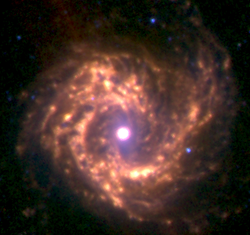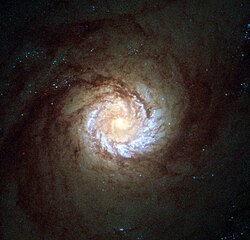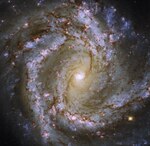Messier 61
| Messier 61[1] | |
(c) ESA/Hubble, CC BY 4.0 Seyfertgalaxen M61 fotograferad av Hubbleteleskopet 28 april 2014.[2] | |
| Observationsdata | |
|---|---|
| Stjärnbild | Jungfrun[3] |
| Rektascension | 12t 21m 54,9s[4] |
| Deklination | +04° 28′ 25″[5] |
| Rödförskjutning | 0,005224 ± 0,000007[4] km/s |
| Avstånd | 52,5 ± 2,3 (16,10 ± 0,71 Mpc) miljoner ljusår |
| Typ | Seyfertgalax, SAB(rs)bc,[4] |
| Skenbar storlek | 6,5 × 5,8 bågminuter[6] |
| Skenbar magnitud | +10,18 |
| Upptäckt | |
| Upptäcktsår | 1779 |
| Upptäckare | Barnaba Oriani |
| Andra beteckningar | |
| M61, NGC 4303, UGC 7420, PGC 40001, MCG +01-32-022, CGCG 42-45, 2MASX J12215494+0428249, IRAS 12194+0444, IRAS F12193+0445, HIPASS J1221+04, RX J1221.9+0429 Z 1219.3+0445, BWE 1219+0445, MITG J122151+0428, 1RXS J122155.6+042919, BEC2010 HRS 114, 2E 2676, MRC 1219+047, SDSS J122154.92+042825.6, CHM2007 HDC 720 J122154.94+0428249, 2E 1219.3+0445, TC E21, CHM2007 LDC 904 J122154.94+0428249, GB6 B1219+0444, NVSS J122154+042825, M98c 121921.4+044458, 87GB 121922.1+044508, NVSS B121921+044503, UZC J122155.0+042824, VV2000c J122154.9+042825, PMN J1221+0428, VCC 508, VV2003c J122154.9+042825, PSCz Q12194+0444, WB 1219+0445, VV2006c J122154.9+042825, QDOT B1219241+044452, WVFSCC J122156+042740, VV2010c J122154.9+042825, RGB J1221.8+0429, 2XMM J122154.8+042825, VV98c J122154.9+042825, RX J122155+04290[5], GC 2878 | |
| Se även: Galaxer, Lista över galaxer | |
Messier 61 (M61) även känd som NGC 4303, är en spiralgalax i Virgohopen i stjärnbilden Jungfrun. Den upptäcktes den 5 maj 1779 av Barnaba Oriani sex dagar innan Charles Messier upptäckte samma galax. Messier hade observerat den samma natt som Oriani men hade misstagit den för en komet.[7] Den av fyra spiralgalaxer som förekommer i Messiers katalog.
Galaxen tros ha ett supermassivt svart hål i centrum, med en beräknad massa av fem miljoner solmassor.[8]

Egenskaper
Messier 61 är en av de största medlemmarna i Virgohopen och tillhör en mindre undergrupp som kallas S Cloud.[9][10] Den morfologiska klassificeringen av SAB(rs)bc[4] anger en svagt spärrad spiral (SAB) med antydan till en ringstruktur och måttlig till löst lindade spiralarmar.[11] Den har en aktiv galaktisk kärna[12] och klassificeras som en starburstgalax som har en kärna av massiva stjärnor med en beräknad massa av 105 solmassor och en ålder av 4 miljon år,[13] och ett antaget centralt supermassivt svart hål med en massa av omkring 5×106 solmassor.[8] Det ligger tillsammans med en äldre massiv stjärnhop och en sannolik äldre starburst.[13] Bevis för betydande stjärnbildning och en aktiv ljusstark nebulosa syns ovanför M61:s skiva.[14] Till skillnad från de flesta spiralgalaxer av sen typ inom Virgohopen visar Messier 61 ett ovanligt överskott av neutralt väte (H I) [15]
Extragalaktiska supernovor
Åtta extragalaktiska supernovor har hittills observerats i Messier 61, vilket gör den till en av de mest framträdande galaxerna för sådana katastrofala händelser.[16][17][7] Dessa är SN 2020jfo,[18] SN 2014dt, SN 2008in, SN 2006ov, SN 1999gn, SN 1964F, SN 1961I,[17] och den första som observerades, Typ II-K SN 1926A, som publicerades den 9 maj 1926.[17][19]
Galleri
- Spiralgalaxen Messier 61 sedd från jorden.[20]
- Messier 61-bild av data från Hubbles vidvinkelkamera 2
- Amatörbild av Messier 61, som visar supernova 2008 den 16 april 2009.
- Infraröd bild av M61 tagen av Spitzer Space Telescope
- Messier 61 med SN2020jfo (supernova) observerad den 15 maj 2020.
- M61 galaxbild som innehåller data inte bara från Hubble, utan även från FORS-kameran vid European Southern Observatorys mycket stora teleskop.
Referenser
- Den här artikeln är helt eller delvis baserad på material från engelskspråkiga Wikipedia, 31 maj 2021.
Noter
- ^ Tschöke, D.; Hensler, G.; Junkes, N. (2000). ”X-rays from the barred galaxy NGC 4303”. Astronomy and Astrophysics 360 (2): sid. 447–456. Bibcode: 2000A&A...360..447T.
- ^ ”A hungry starburst galaxy”. ESA/Hubble Picture of the Week. http://www.spacetelescope.org/images/potw1417a/. Läst 29 april 2014.
- ^ Sinnott, R. W., red (1988). The Complete New General Catalogue and Index Catalogue of Nebulae and Star Clusters by J. L. E. Dreyer. Sky Publishing Corporation and Cambridge University Press. ISBN 978-0-933346-51-2
- ^ [a b c d] ”NASA/IPAC Extragalactic Database”. Results for M 61. http://ned.ipac.caltech.edu/cgi-bin/objsearch?objname=Messier+61&extend=no&hconst=73&omegam=0.27&omegav=0.73&corr_z=1&out_csys=Equatorial&out_equinox=J2000.0&obj_sort=RA+or+Longitude&of=pre_text&zv_breaker=30000.0&list_limit=5&img_stamp=YES.
- ^ [a b] ”Basic data: M 61 -- Seyfert 2 Galaxy” (på engelska). SIMBAD. Centre de Données astronomiques de Strasbourg. http://simbad.u-strasbg.fr/simbad/sim-basic?Ident=Messier+61&submit=SIMBAD+search. Läst 3 september 2014.
- ^ ”Images and maps in NED archive for object Messier 061” (på engelska). NASA/IPAC Extragalactic Database. http://ned.ipac.caltech.edu/cgi-bin/imgdata?objname=Messier+61. Läst 3 september 2014.
- ^ [a b] ”Messier 61”. SEDS Messier Database. Arkiverad från originalet den 6 januari 2017. https://web.archive.org/web/20170106175502/http://messier.seds.org/m/m061.html/. Läst 31 maj 2021.
- ^ [a b] Pastorini, G.; Marconi, A.; Capetti, A.; Axon, D. J.; Alonso-Herrero, A.; Atkinson, J.; Batcheldor, D.; Carollo, C. M.; et al. (2007). ”Supermassive black holes in the Sbc spiral galaxies NGC 3310, NGC 4303 and NGC 4258”. Astronomy and Astrophysics 469 (2): sid. 405–423. doi:. Bibcode: 2007A&A...469..405P.
- ^ ”Galaxy On Line Database Milano Network (GOLDMine)”. Galaxy On Line Database Milano Network (GOLDMine). http://goldmine.mib.infn.it/. Arkiverad 3 juni 2012 hämtat från the Wayback Machine.
- ^ ”The Virgo Cluster”. The Virgo Cluster. http://www.atlasoftheuniverse.com/galgrps/vir.html.
- ^ de Vaucouleurs, Gérard (April 1963). ”Revised Classification of 1500 Bright Galaxies”. Astrophysical Journal Supplement 8: sid. 31. doi:. Bibcode: 1963ApJS....8...31D.
- ^ Jiménez-Bailón, E.; Santos-Lleó, M.; Mas-Hesse, J. M.; Guainazzi, M.; Colina, L.; Cerviño, M.; González Delgado, Rosa M. (2003). ”Nuclear Activity and Massive Star Formation in the Low-Luminosity Active Galactic Nucleus NGC 4303: Chandra X-Ray Observations”. The Astrophysical Journal 593 (1): sid. 127–141. doi:. Bibcode: 2003ApJ...593..127J.
- ^ [a b] Colina, L.; Gonzalez Delgado, R.; Mas-Hesse, J. Miguel; Leitherer, C.; Jimenez Bailon, E. (2002). ”Detection of a Super-Star Cluster as the Ionizing Source in the Low-Luminosity Active Galactic Nucleus NGC 4303”. The Astrophysical Journal 579 (2): sid. 545–553. doi:. Bibcode: 2002ApJ...579..545C.
- ^ Koopmann, R.; Kenney, J. D. P. (2004). ”Hα Morphologies and Environmental Effects in Virgo Cluster Spiral Galaxies”. The Astrophysical Journal 613 (2): sid. 866–885. doi:. Bibcode: 2004ApJ...613..866K.
- ^ Kenney, J. D.; Young, J. S. (1986). ”CO in H I-deficient Virgo cluster spiral galaxies”. The Astrophysical Journal Letters 301: sid. L13–L17. doi:. Bibcode: 1986ApJ...301L..13K.
- ^ Supernovae which have been observed in Messier catalog galaxies
- ^ [a b c] ”List of Supernovae”. List of Supernovae. Central Bureau for Astronomical Telegrams. http://www.cbat.eps.harvard.edu/lists/Supernovae.html.
- ^ ”SN 2020fqv TNS”. Arkiverad från originalet den 28 november 2020. https://web.archive.org/web/20201128114031/https://wis-tns.weizmann.ac.il/object/2020jfo. Läst 31 maj 2021.
- ^ Boffi, F.R.; Sparks, W.B.; Macchetto, F.D. (1999). ”A search for candidate light echoes: Photometry of supernova environments”. Astronomy and Astrophysics Supplement Series 138 (2): sid. 253–266. doi:. Bibcode: 1999A&AS..138..253B.
- ^ ”A portrait of a beauty” (på engelska). www.eso.org. https://www.eso.org/public/images/potw1901a/.
Externa länkar
 Wikimedia Commons har media som rör Messier 61.
Wikimedia Commons har media som rör Messier 61.- messier.seds.org/m/m061.html
| ||||||||
Media som används på denna webbplats
The NASA/ESA Hubble Space Telescope has captured this image of nearby spiral galaxy Messier 61, also known as NGC 4303. The galaxy, located only 55 million light-years away from Earth, is roughly the size of the Milky Way, with a diameter of around 100 000 light-years. The galaxy is notable for one particular reason — six supernovae have been observed within Messier 61, a total that places it in the top handful of galaxies alongside Messier 83, also with six, and NGC 6946, with a grand total of nine observed supernovae.
In this Hubble image the galaxy is seen face-on as if posing for a photograph, allowing us to study its structure closely. The spiral arms can be seen in stunning detail, swirling inwards to the very centre of the galaxy, where they form a smaller, intensely bright spiral. In the outer regions, these vast arms are sprinkled with bright blue regions where new stars are being formed from hot, dense clouds of gas.
Messier 61 is part of the Virgo Galaxy Cluster, a massive group of galaxies in the constellation of Virgo (the Virgin). Galaxy clusters, or groups of galaxies, are among the biggest structures in the Universe to be held together by gravity alone. The Virgo Cluster contains more than 1300 galaxies and forms the central region of the Local Supercluster, an even bigger gathering of galaxies.
The image was taken using data from Hubble’s Wide Field Camera 2. Different versions of this image were submitted to the Hubble’s Hidden Treasures image processing competition by contestants Gilles Chapdelaine, Luca Limatola, and Robert Gendler.Författare/Upphovsman: Raysastrophotograhy, Licens: CC BY-SA 4.0
This SN2020jfo is quite bright, observed on May 15, 2020 as recorded by Raman Madhira from Ray's Astrophotography Observatory. A 11 inches RASA telescope plus a color CMOS was used
Författare/Upphovsman: ESA/Hubble & NASA, ESO, J. Lee and the PHANGS-HST Team, Licens: CC BY 4.0
The luminous heart of the galaxy M61 dominates this image, framed by its winding spiral arms threaded with dark tendrils of dust. As well as the usual bright bands of stars, the spiral arms of M61 are studded with ruby-red patches of light. Tell-tale signs of recent star formation, these glowing regions lead to M61’s classification as a starburst galaxy.
Though the gleaming spiral of this galaxy makes for a spectacular sight, one of the most interesting features of M61 lurks unseen at the centre of this image. As well as widespread pockets of star formation, M61 hosts a supermassive black hole more than 5 million times as massive as the Sun.
M61 appears almost face-on, making it a popular subject for astronomical images, even though the galaxy lies more than 52 million light-years from Earth. This particular astronomical image incorporates data from not only Hubble, but also the FORS camera at the European Southern Observatory’s Very Large Telescope, together revealing M61 in unprecedented detail. This striking image is one of many examples of telescope teamwork — astronomers frequently combine data from ground-based and space-based telescopes to learn more about the Universe.Författare/Upphovsman: Hewholooks, Licens: CC BY-SA 3.0
Supernova SN2008in in spiral galaxy Messier 61
(c) ESA/Hubble, CC BY 4.0
This new Hubble picture is the sharpest ever image of the core of spiral galaxy Messier 61. Taken using the High Resolution Channel of Hubble's Advanced Camera for Surveys, the central part of the galaxy is shown in striking detail.
Also known as NGC 4303, this galaxy is roughly 100 000 light-years across, comparable in size to our galaxy, the Milky Way. Both Messier 61 and our home galaxy belong to a group of galaxies known as the Virgo Supercluster in the constellation of Virgo (The Virgin) — a group of galaxy clusters containing up to 2000 spiral and elliptical galaxies in total.
Messier 61 is a type of galaxy known as a starburst galaxy. Starburst galaxies experience an incredibly high rate of star formation, hungrily using up their reservoir of gas in a very short period of time (in astronomical terms). But this is not the only activity going on within the galaxy; deep at its heart there is thought to be a supermassive black hole that is violently spewing out radiation.
Despite its inclusion in the Messier Catalogue, Messier 61 was actually discovered by Italian astronomer Barnabus Oriani in 1779. Charles Messier also noticed this galaxy on the very same day as Oriani, but mistook it for a passing comet — the comet of 1779.
A version of this image was submitted to the Hubble’s Hidden Treasures image processing competition by Flickr user Det58.Författare/Upphovsman: Ingen maskinläsbar skapare angavs. Med antaget (baserat på upphovsrättsanspråk)., Licens: CC BY 2.5
Image of the M61 galaxy in infrared at 3.6 (blue), 5.8 (green) and 8.0 µm. The image has been made by myself (Médéric Boquien) from the public image archive of the Spitzer Space Telescope (courtesy NASA/JPL-Caltech).
Författare/Upphovsman: Credit: ESO, Licens: CC BY 4.0
A portrait of a beauty
Nuzzled in the chest of the constellation Virgo (the Virgin) lies a beautiful cosmic gem — the galaxy Messier 61. This glittering spiral galaxy is aligned face-on towards Earth, thus presenting us with a breathtaking view of its structure. The gas and dust of the intricate spiral arms are studded with billions of stars. This galaxy is a bustling hub of activity with a rapid rate of star formation, and both a massive nuclear star cluster and a supermassive black hole buried at its heart.
Messier 61 is one of the largest members of the Virgo Cluster, which is made up of more than a thousand galaxies, and is itself at the centre of the Virgo Supercluster — to which our Milky Way also belongs. This dazzling beauty was first discovered in 1779, and it has been capturing astronomers’ interest ever since. Set against a dark sky littered with galaxies, this image shows the awe-inspiring M61 in its full glory — even at its distance of over 50 million light-years.
This image was taken as part of ESO’s Cosmic Gems Programme, an outreach initiative to produce images of interesting, intriguing or visually attractive objects using ESO telescopes, for the purposes of education and public outreach. The programme makes use of telescope time that cannot be used for science observations. In case the data collected could be useful for future scientific purposes, these observations are saved and made available to astronomers through ESO’s Science Archive.
Credit:
ESO
Coordinates Position (RA): 12 21 57.51 Position (Dec): 4° 28' 25.12" Field of view: 6.11 x 6.24 arcminutes Orientation: North is -0.0° left of vertical Colours & filters Band Wavelength Telescope Optical b 440 nm Very Large Telescope FORS2 Optical v 557 nm Very Large Telescope FORS2 Infrared R 655 nm Very Large Telescope FORS2 Optical H-alpha 656 nm Very Large Telescope FORS2.

![Spiralgalaxen Messier 61 sedd från jorden.[20]](http://upload.wikimedia.org/wikipedia/commons/thumb/2/23/Messier61_-_ESO_-_Potw1901a.tif/lossy-page1-147px-Messier61_-_ESO_-_Potw1901a.tif.jpg)












